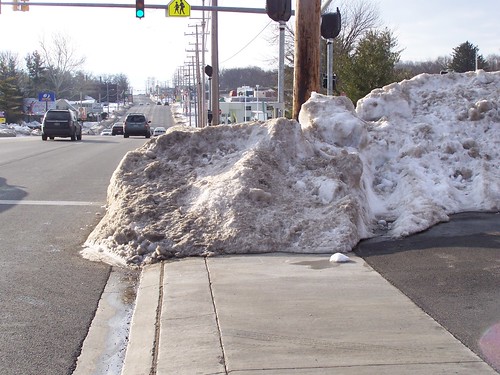Level of service and maintenance requirements in planning #2: winter maintenance of bike paths

I have a bunch of "complaints" about bike and pedestrian master plans in terms of how planning consulting firms approach the engagements and what the plans cover. I used to think the main firms involved in this work were amazing, but now I see many gaps in the structure and approach to the plans, which comes out in the finished product, and then for good or ill, shapes how communities implement the plans (and they sure can't implement recommendations that don't exist).
One element frequently left out of bike and pedestrian plans is a discussion of maintenance, and setting level of service standards for maintenance, especially for the winter months, in those parts of the country where snow is likely.
I have a long piece about this general problem, "A "maintenance of way" agenda for the walking and transit city," that makes the point that communities prioritize snow removal from streets, but if our communities claim that they focus mobility towards walking and biking, then snow removal practices have to change so that walking, using transit, and biking isn't compromised by snow.
(Note that while I think there are some problems with DC's Metropolitan Branch Trail--inadequate lighting, not clear if there is a security plan, inadequate signage on and off the trail, no emergency communications system--they do clear the snow as necessary. I don't ride the Anacostia Riverwalk Trail enough to know if they do so there too.)
In bike plans, the best section on maintenance that comes to mind was in the previous edition not the current edition of the bike plan for Minneapolis (the current Bicycle Master Plan covers maintenance requirements just fine on p. 89 and funding for maintenance on p. 192, but the previous plan had a more extended discussion). But apparently that section was drawn from the October 2000 Bikeways Report, which set the policy and practice for winter maintenance, making very clear that the Parks and Recreation Board was responsible for winter maintenance of off-road trails defined as transportation routes.
I don't recall reading another bicycle master plan that requires winter maintenance to this level.
 Right: at this intersection on York Road, snow was deposited on the sidewalk at the intersection, forcing pedestrians into the roadway in order to continue.
Right: at this intersection on York Road, snow was deposited on the sidewalk at the intersection, forcing pedestrians into the roadway in order to continue.When I wrote the plan for Western Baltimore County, I had an extended section on experiential qualities of design, engineering, and maintenance that was mostly excised from the posted draft, and this section included standards for sidewalk (I am really bugged by projections of plants and trees into walkways) and trail maintenance. For Baltimore County, I recommended that trails in the "urban county" have snow cleared, while trails in the rural county (often used for cross country skiing in winter) would not have snow cleared in the winter months.
This comes up in Arlington County, where the master transportation plan has recommended for almost two decades that trails have snow cleared in winter, but because the trails typically are maintained by the parks department, not the agency responsible for roads, this hasn't happened. See "Arlington bicyclists want paths plowed when it snows" from the Examiner.
So it's not just a matter of setting LOS requirements, it's also ensuring that the right systems and processes are set up to ensure that recommendations are implemented.
For what it's worth, a trail friends group in Greater Boston pays for snow clearance on the Minuteman Trail, see "On Minuteman Bikeway in winter, beginning to see their way clear" from the Boston Globe and "Bikers enjoying smoother commute through Lexington" from the WickedLocal website. Although the trail organization prefers that the city take on the responsibility.
Labels: bicycling, car culture and automobility, provision of public services, public space management, snow removal, transportation planning



0 Comments:
Post a Comment
<< Home